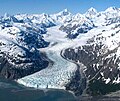| Mount Tlingit | |
|---|---|
 Mt. Tlingit centered at top (Mt. Fairweather to right) Aerial view from east (1973) | |
| Highest point | |
| Elevation | 12,606 ft (3,842 m) [1] [2] |
| Prominence | 2,056 ft (627 m) [2] |
| Parent peak | Mount Quincy Adams (13,620 ft) [2] |
| Isolation | 2.34 mi (3.77 km) [2] |
| Listing |
|
| Coordinates | 58°53′35″N137°23′38″W / 58.89306°N 137.39389°W [1] |
| Naming | |
| Etymology | Tlingit |
| Geography | |
 | |
| Interactive map of Mount Tlingit | |
| Location | Hoonah–Angoon Census Area Alaska, United States |
| Protected area | Glacier Bay National Park |
| Parent range | Fairweather Range [1] Saint Elias Mountains |
| Topo map | USGS Mount Fairweather D-5 |
| Climbing | |
| Easiest route | Mountaineering |
Mount Tlingit is a 12,606-foot (3,842-meter) mountain summit in Alaska, United States. It lies approximately 2 miles southeast of Mount Quincy Adams and 5 miles east of Mount Fairweather.








